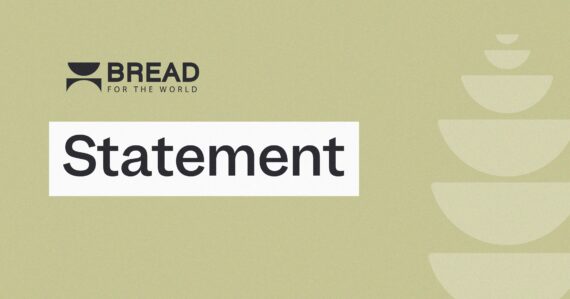It’s the beginning of a new school year—a good time to take a fresh look at the National School Lunch Program (NSLP) and identify some improvements that could make it even more effective. Bread for the World is a longtime supporter of programs such as the NSLP which provide children from low-income families with nutritious food.
The NSLP is second only to the Supplemental Nutrition Assistance Program (SNAP) in the number of people it serves. In 2022, the program provided healthy meals to 30 million children, two-thirds of them free or at a reduced price.
Children are eligible for free school meals if they live in households with incomes of 130 percent of the federal poverty level or less. In 2023, this means a family of three that earns $29,940 a year or less. Children in households that earn between 130 percent and 185 percent of the poverty level are eligible for reduced-price meals.
The NSLP was established in 1946, making it the longest continually operating federal nutrition program. It has always had a rationale based in national security concerns. More than one-third of potential Army recruits for World War II were rejected because they had health problems associated with poor nutrition. As the U.S. military shifted its focus from winning World War II to waging the so-called Cold War against the Soviet Union, civilian and military leaders became increasingly alarmed about poor nutrition among children and teens.
Military leaders continue to support the school lunch program wholeheartedly as a vital component of national security. The NSLP provides most children, especially those growing up in low-income families, with some of the healthiest food they are likely to eat on a given day.
The COVID-19 global pandemic meant that the U.S. government needed to respond to the population’s needs in new ways. For two school years, all children, regardless of family income, were eligible for free meals at participating schools. This was a radical change: before the pandemic, universal free school lunch and breakfast were not White House or congressional priorities.
It was a blow when, before the start of the 2022-2023 school year, Congress allowed universal access to free school meals to expire, which Bread and other advocacy organizations fought to prevent. Since then, policymakers in several states have worked to establish universal access. At this writing, seven states have enacted legislation that provides free meals for all students: California, Maine, Colorado, Minnesota, New Mexico, Vermont, and Michigan. Several others are making progress towards such legislation.
Children in other states, however, are being left out. Making school meals available to all children is the original objective of NSLP and the School Breakfast Program. U.S. taxpayers fund school meal programs, and it is the responsibility of the federal government to ensure that all children have equitable access to them.
The next best thing to universal school meals is a policy known as the Community Eligibility Provision (CEP). This allows schools with 40 percent or more of their students eligible for federal nutrition assistance to offer free meals to all their students, and more than 82 percent of the eligible schools did so during the 2022-2023 school year.
The 40 percent eligibility threshold is too high, however. Reducing it would enable the community eligibility provision to benefit more children. The U.S. Department of Agriculture (USDA) has proposed lowering the minimum percentage of eligible students to 25 percent. Bread for the World, noting USDA’s definition of a “high poverty” area as one where 20 percent or more of the households have incomes below the poverty line, suggests reducing the percentage to be consistent with the rate the agency considers high poverty in similar contexts.
Congress could take up this question of expanding which children are impacted by living in high poverty areas in the next Child Nutrition Reauthorization (CNR). The community eligibility provision was itself new in the most recent CNR, which made other major improvements as well. However, the most recent reauthorization was in 2010, meaning that a renewal—with opportunities to include policy improvements in all child nutrition programs —was due in 2015. The start of a new school year is a good time to point out that Congress is eight years late, and counting, to reauthorize child nutrition.
The COVID-19 pandemic spurred another transformational change that benefited the country’s low-income children. In 2021, an expansion of the Child Tax Credit (CTC) had an unprecedented impact: child poverty dropped by 30 percent. CTC expansion no doubt contributed to sizeable reductions in child hunger as well.
Despite this remarkable progress—and to the astonishment of many anti-hunger advocates who have been working toward significant steps forward such as this—Congress let the CTC expansion expire after six months. We will know more about the impacts of this decision on children and families later this year when USDA publishes Household Food Security in the United States in 2022.
Todd Post is senior domestic policy advisor, Policy and Research Institute, with Bread for the World.
This article appears in the August 2023 edition of Bread for the World’s Institute Insights newsletter. Institute Insights provides an in-depth look at the causes of hunger and malnutrition and offers potential solutions to address them. Click here to sign up for the monthly Institute Insights newsletter.



